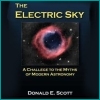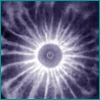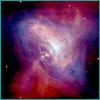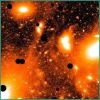|
Plasma
Introduction
History
I
History
II
Technical I
Technical II
Further
FAQs The
Electric Universe Science
and Philosophy Ancient
Testimony
Cutting Edge The
Way Forward Latest
News
Video |
 | |
 |
 |
| Technical overview II |
|
|
| |
|
|
| Dr Charles Bruce FIEE, FIP, FRAS |
|
|
| |
|
|
|
Dr Charles Bruce was an expert in high voltage electrical
engineering and a Fellow of The Royal Astronomical Society.
In the 1940s he made a remarkable proposal that is still
ignored by mainstream astronomy to this day. His proposal
supports the electrodynamic paradigm.
Bruce identified cosmic jets, solar flares, magnetic
fields and high temperatures in space as electrical
discharge phenomena.
"And even if one regards the electric
fields as merely another postulate, it has the great
advantage that it is the one postulate which, in my
view, renders all the others unnecessary."
C. E.
R Bruce, Electric Fields in Space, Penguin Science,
1968
Bruce also identified the beautiful bipolar
planetary nebula pictured in the heading image above as an electrical phenomena.
|
|
 |
| |
|
|
| The Electric Sky, Don Scott |
|
 |
| |
|
|
Don Scott is a retired professor of Electrical Engineering,
with a long term interest in astronomy and cosmology.
His book The Electric Sky contains sensible science
that can be understood by both amateurs and experts
alike. Published late 2006, it represents another substantial
public exposition of the latest developments that further
challenge the current 'gravity only' system of thinking. Update 2022: His latest book The Interconnected Cosmos is available here.
|
|
| |
|
|
| The Plasma Gun |
|
|
| |
|
|
The plasma gun, pictured below, is a simple plasma
focus device, consisting of two metal tubes, one inside
the other. They have been successful in concentrating
plasma discharges over at least four decades of research.

The energy stored in a large bank of capacitors is
concentrated into a tiny filamentary knot, shaped like
a donut, and known as a plasmoid. When plasmoid vortexes
collapse, two intense plasma filaments are fired along
the axis. The term plasmoid was coined by the plasma physicist Winston H. Bostick. He discovered plasma focus and plasma vortex phenomena, and he simulated cosmical astrophysics in laboratory experiments.
Pictured above right is the view down the barrel of
a plasma gun.
The same process can be seen at the core of spiral
galaxies and in powerful stellar outbursts. Pictured
right is Nebula NGC 6751. Plasma phenomena, of course,
are scalable over many orders of magnitude. The compact
energetic activity at the core of galaxies is thus explained
in simple electrical terms. In Plasma Cosmology there
is no need for mathematical abstraction. Who needs Black
Holes?
Devices based on the plasma gun are being developed
to generate neutron beams, x-rays, and nuclear fusion
devices. The future of space travel probably rests on
these.
"Active galactic nuclei (AGNs) release vast amounts of energy, whose ultimate source is a supermassive black hole in the galactic nucleus. In so-called radio-loud AGNs, two relativistic jets of plasma emanate from the nucleus, presumably along the rotational axis of the black hole."
Denize C. Gabuzda, Matt Nagle, Naomi Roche
The Jets of AGN as Giant Co-axial Cables
In other words, pop science (as per the quote above) is still struggling to let go of black holes and gravity, even when the evidence is in front of their face ... and after they acknowledge the resulting plasma and EM phenomena. Truly bizarre. |
|
 |
| |
| Above. Looking down the barrel of
a plasma focus gun. |
| |
 |
| |
| Above. 3D view of a cosmic plasma
gun, the M1 Pulsar. |
| Below. Looking down the barrel of Nebula NGC 6751. |
| |
 |
|
|
| |
|
|
| Plasma focus
vis-à-vis Black Holes |
|
|
| |
|
|
|
The existence of Black Holes is no longer questioned
in conventional astronomy, despite the fact that they
are based entirely on theoretical assumptions. (Update. In 2019 it was claimed that a black hole had been pictured for the first time, although the pictures appear to be plasmas in glow mode surrounding the alleged BH at the center of galaxy M87. Furthermore, the pictures are composite.)
However, astronomers using NASAs Hubble Space Telescospe
have identified the source of a mysterious blue light
surrounding a 'super-massive black hole' in our neighboring
Galaxy, Andromeda M31. It originates from a disk of
hot, young stars that whip around the 'black hole' in
much the same way that planets in our solar system revolve
around the Sun. Astronomers are perplexed about how
this disk of stars could form so close to a giant black
hole. They should, of course, be sucked into oblivion,
but this isn't happening.
Similar stars close to the core of our Milky Way galaxy
have also been observed.
None of this perplexes astronomers who are familiar
with plasma. They can generate similar effects in a
plasma lab with the plasma focus device (above): It
is the plasmoid that forms and stores energy at the
focus of the discharge. When the plasmoid reaches a
critical energy level, it discharges its energy in a
collimated jet along its axis in the form of electromagnetic
radiation and neutrons. Being unstable outside a nucleus,
the neutrons soon decay into protons and electrons.
The electrons are held back by the electromagnetic field,
and the high-speed protons are beamed away. On a galactic scale this is probably the mechanism
that produces the collimated jets streaming away from
the cores of active galaxies. The masses of ejected
protons may make up the quasars that are associated
with these galaxies and could be the basis for their intrinsic redshift.
Stephen Hawking has put forward a new
theory about black holes, suggesting that they do
not destroy everything that strays into their path.
The implications are profound for gravitational theory, and do
not surprise those who favour the plasma focus model.
The power source in a plasma gun is understood and
can be shown to actually work (using electric currents).
An infinitely strong gravitational field has never been
shown to exist, plus there needs to be a mechanism that
converts the (gravitational) potential energy into plasma
effects, which are clearly the end product.
|
|
|
| |
|
|
| Intergalactic
plasma circuits |
|
|
| |
|
|
|
A new technique has revealed faint structures amidst
the galaxies of the Virgo Cluster. Plasma cosmologists
immediately recognise the 'cocoons, plumes, and streamers'
as Birkeland currents and plasma sheaths. This is direct
confirmation of the intergalactic circuits predicted
by the plasma model.
The 'pinch effect' organises plasmas into filaments
that act as 'power cables'. These can attract and repel,
and when close can spiral around each other. At points
of sufficiently strong interaction, the matter in these
cables will be stretched into arcs and/or bulges that
can generate the familiar forms of a spiral galaxy.
|
|
 |
| |
|
|
| "Mysterious
Ribbons" |
|
|
| |
|
|
|
The NASA spacecraft, IBEX, has recently discovered
another shock for the mainstream, if you'll pardon the
pun, yet again. Researchers describe it as a “ribbon”
of highly energetic particles at the boundary of our
solar system, and it has them puzzled.
From the article at Physics World Oct 2009:
"The instruments
measure and count particles known as energetic neutral
atoms. These arise from an area called the interstellar
boundary. This zone, undetectable by normal telescopes,
is where electrically charged particles flowing from
the sun, called the solar wind, pass far beyond the
planets and plow into the gas and dust of the larger
galaxy ... We expected
to see small, gradual spatial variations
at the interstellar boundary,”
McComas told physicsworld.com, a website
of the London based Institute of Physics.
Scientists think the finding doesn’t
fit with the accepted model of the heliosphere,
thought to be shaped like a comet by the collision
of the outgoing solar wind and a greater
galactic wind."
Though I tire of saying it, these mysterious
ribbons are expected and predicted by the plasma model.
In this particular case, these filaments clearly connect
our solar system with the electrical supply of the wider
galaxy.
|
|
|
| |
|
|
| Cosmic Tornadoes |
|
|
| |
|
|
|
The discovery of Herbig Haro objects, or 'jetted stars',
leaves astronomers scratching their heads. The Astronomy
Picture of the Day, February 3, 2006, had this to say:
“Though such energetic outflows are well known
to be associated with the formation of young stars,
the exact cause of the spiralling structures apparent
in this case is still mysterious.”
In reality, these structures highlight THE fundamental
misunderstanding of space! The only force known to prevent
a stream of gas from rapidly dispersing in the near
vacuum of space is magnetism, and only electric currents
can generate magnetic fields. The trouble is, early in the twentieth century, the
astronomical community decided that gravity rules the
heavens, and having settled on this secure and mathematically
elegant vision of the cosmos, they are reluctant to
entertain ideas about more exotic forces playing any
significant role. Most of these objects are many light years in length,
and display the classic signatures of Plasma/EM behaviour
— 'beading', spiralling, and 'kink' or 'sawtooth' instabilities.
As Alfvén pointed out, time after
time, the underlying assumptions of cosmologists today “are developed with the most sophisticated mathematical
methods and it is only the plasma itself which does
not ‘understand’ how beautiful the theories
are and absolutely refuses to obey them.”
|
|
 |
| |
|
|
| Plate Tectonics,
Earthquakes, and more |
|
|
| |
|
|
| This fascinating
paper examines the limitations of a thermally driven model
of the earth, and outlines an alternative solid-plastic-planet
model, possibly expanding, and driven by electromagnetic
forces. The paper
is technical but approachable. External link: https://www.scientificexploration.org/ |
|
|
|  |
 | |
 |
|
